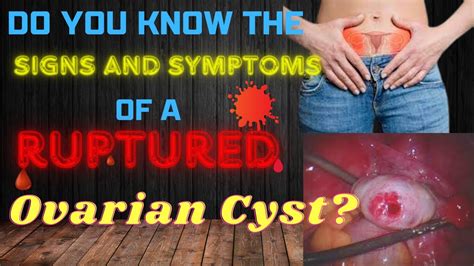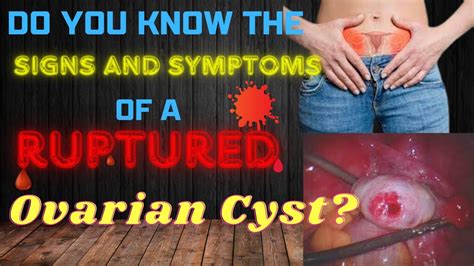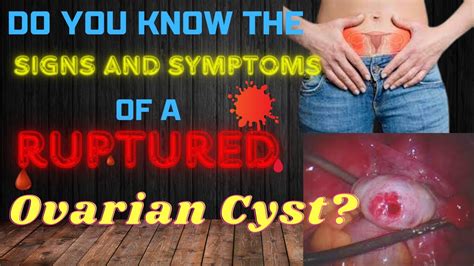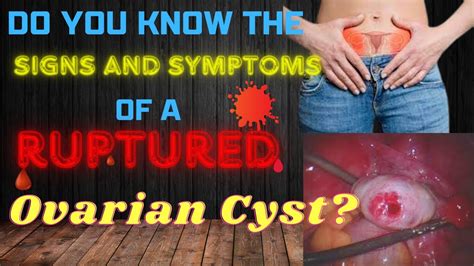Intro
Identify 5 key ovarian cyst rupture symptoms, including severe pelvic pain, heavy bleeding, and nausea. Learn to recognize signs of a ruptured ovarian cyst and related conditions like endometriosis and PCOS.
Ovarian cysts are fluid-filled sacs that can develop on the ovaries, and in most cases, they are harmless and resolve on their own. However, in some instances, these cysts can rupture, leading to a range of symptoms that can be uncomfortable and even life-threatening. It is essential to recognize the signs of an ovarian cyst rupture to seek medical attention promptly. The importance of understanding these symptoms cannot be overstated, as timely intervention can significantly improve outcomes and reduce the risk of complications.
Recognizing the symptoms of an ovarian cyst rupture is crucial for women's health, as it can help prevent severe consequences, including infection, hemorrhage, and even infertility. Moreover, being aware of the signs and symptoms can enable individuals to take proactive steps to manage their condition and seek medical help when necessary. The prevalence of ovarian cysts and the potential for rupture underscore the need for education and awareness about this critical women's health issue.
The potential consequences of an ovarian cyst rupture make it vital to understand the underlying causes and risk factors associated with this condition. Factors such as hormonal changes, genetics, and certain medical conditions can contribute to the development of ovarian cysts, which can increase the likelihood of rupture. By understanding these factors and recognizing the symptoms of an ovarian cyst rupture, individuals can take steps to mitigate their risk and ensure timely medical intervention.
Ovarian Cyst Rupture Overview

Causes and Risk Factors
The causes of ovarian cyst rupture are not always clear, but several factors can increase the risk of rupture. These include hormonal changes, genetics, and certain medical conditions such as endometriosis or polycystic ovary syndrome (PCOS). Additionally, factors such as pregnancy, trauma, or certain medications can also contribute to the development and rupture of ovarian cysts. Recognizing these risk factors can help individuals take proactive steps to manage their condition and reduce their risk of complications.Symptoms of Ovarian Cyst Rupture

Diagnosis and Treatment
Diagnosing an ovarian cyst rupture typically involves a combination of physical examination, imaging studies such as ultrasound or CT scan, and laboratory tests to rule out other conditions. Treatment for an ovarian cyst rupture usually involves surgical intervention to remove the ruptured cyst and any affected tissue. In some cases, medication may be prescribed to manage symptoms and prevent infection. In severe cases, hospitalization may be necessary to monitor for complications and provide supportive care.Complications of Ovarian Cyst Rupture

Prevention and Management
Preventing ovarian cyst rupture involves managing underlying risk factors and seeking regular medical check-ups. This may include: * Practicing good reproductive health * Maintaining a healthy weight * Avoiding certain medications or substances * Managing stress and anxiety * Seeking regular gynecological check-ups By taking proactive steps to manage their condition and reduce their risk of complications, individuals can significantly improve their outcomes and quality of life.Ovarian Cyst Rupture and Fertility

Emotional and Psychological Impact
The emotional and psychological impact of an ovarian cyst rupture should not be underestimated. The experience can be traumatic, and individuals may experience anxiety, depression, or stress related to their condition. It is essential to seek support from healthcare providers, family, and friends to manage these emotions and develop coping strategies. By acknowledging the emotional and psychological impact of ovarian cyst rupture, individuals can better navigate their condition and improve their overall well-being.Conclusion and Next Steps

We invite you to share your thoughts, experiences, or questions about ovarian cyst rupture in the comments below. Your engagement can help raise awareness and support for this critical women's health issue. Additionally, consider sharing this article with others who may benefit from this information, and let's work together to promote education and awareness about ovarian cyst rupture.
What are the symptoms of an ovarian cyst rupture?
+The symptoms of an ovarian cyst rupture can include sudden and severe pelvic pain, abdominal tenderness or guarding, nausea and vomiting, fever and chills, vaginal bleeding or discharge, dizziness or fainting, and abdominal swelling or bloating.
How is an ovarian cyst rupture diagnosed?
+Diagnosing an ovarian cyst rupture typically involves a combination of physical examination, imaging studies such as ultrasound or CT scan, and laboratory tests to rule out other conditions.
What are the complications of an ovarian cyst rupture?
+The complications of an ovarian cyst rupture can include hemorrhage or bleeding, infection or abscess formation, sepsis or septic shock, infertility or reproductive problems, adhesions or scar tissue formation, and chronic pelvic pain or discomfort.
